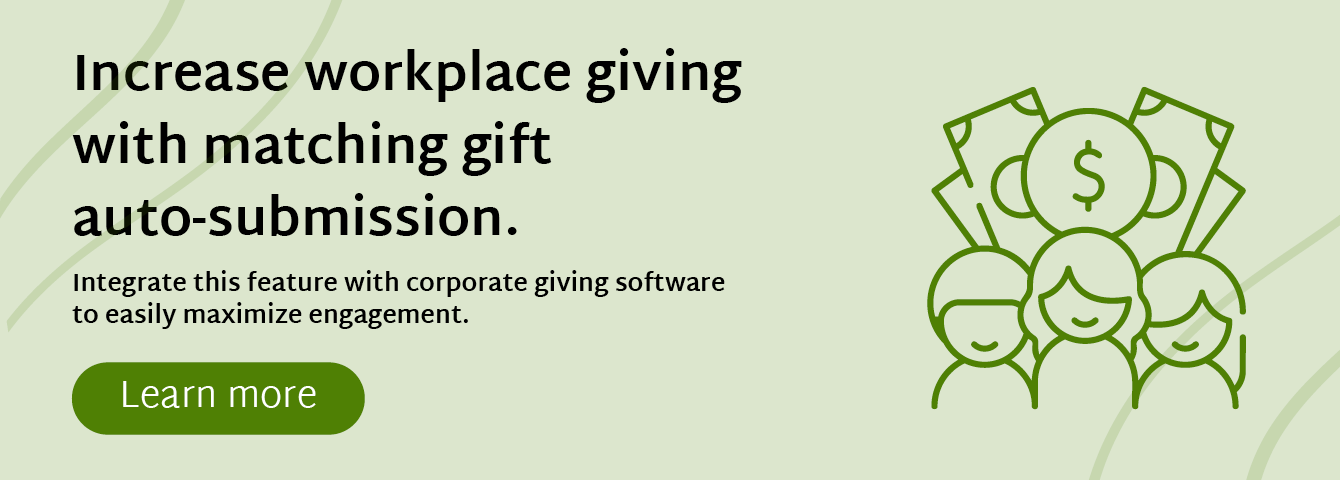Workplace giving is a favorite form of corporate philanthropy for the companies, employees, and nonprofits involved. These programs enable businesses to make the most of generosity and corporate social responsibility (CSR) while encouraging team members to take an active role in their giving success.
If you’re looking to launch a workplace giving program at your company for the first time, this detailed resource is here to guide your way. Here, we’ll cover the seven essential steps to launch an impactful workplace giving initiative.
These include the following tasks:
- Determine the types of giving program(s) you’d like to start.
- Decide whether you’ll manage your giving program in-house.
- If applicable, choose a corporate giving platform to utilize.
- Choose the ways employees can participate in your programs.
- Enable auto-submission functionality to streamline giving.
- Promote your workplace giving programs to employees.
- Recognize your employees’ contributions.
Workplace giving differs from traditional corporate philanthropy in that individual employees drive the programs forward with their own participation. As a result, these employee giving initiatives see greater levels of team-wide engagement while simultaneously enabling charitable-minded companies to make a positive impact on the world around them.
Ready to dive in as we walk through the process of kicking off a workplace giving program? Let’s begin.
1. Determine the types of giving program(s) you’d like to start.
Workplace giving is not a one-size-fits-all philanthropic opportunity. There are tons of ways for tons of businesses to get involved. The types of programs chosen should ultimately depend on what works best for each company and its employees. And remember, you’re not just limited to one program. In fact—the more, the merrier!
Workplace giving initiatives are an effective way to further motivate and engage your employees, so when deciding what type of program to start, speaking to employees should be one of your first steps. Ask them what causes they care about, what giving efforts they already participate in, and how your organization can empower them to help those causes even further.
While the list of programs you can choose from is endless, we recommend incorporating one or more of these powerful workplace giving initiatives:
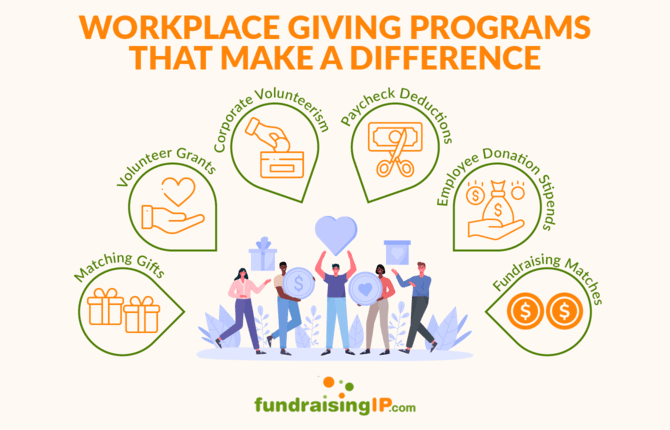
Matching gifts
Companies that implement matching gifts provide corporate donations in response to employee donations. If you’re interested in developing a matching gift program, here’s how to get started:
- Set matchable donation criteria. This includes minimum and maximum donation match amounts, qualifying types of employees, qualifying types of nonprofit causes, and submission deadlines. Then, set the ratio at which you will match employee gifts, such as 1:1.
- Add your program to a matching gift database. Work with popular matching gift databases to get information about your company’s program added. That way, employees can research your program and determine their eligibility whenever they donate to nonprofits.
- Educate your employees. One of the biggest challenges facing donation match programs is a lack of awareness. Be sure to promote the program to your employees and teach them how to submit match requests.
Corporate matching gifts are the easiest way to get started with workplace giving. You’ll show your employees you care about the causes they support, which helps attract and retain top talent while also positioning your company as socially responsible.
Volunteer grants
Like matching gifts, volunteer grants provide corporate contributions to charitable organizations that their employees support. Instead of matching individual donations, however, volunteer grants match hours volunteered with corresponding grant amounts.
For example, let’s say you promise to donate $10 for every hour employees volunteer. After learning about the opportunity, an employee volunteers for 10 hours at a local animal shelter, so your company provides the organization with a $100 donation. If a different team member volunteers for 50 hours at an elementary school, your company may grant the school $500.
Fundraising matches
This type of workplace giving is similar to matching gifts. In fact, some companies even lump matching gifts and fundraising matches into a single workplace giving program. However, there’s one factor that differentiates the two.
360MatchPro’s guide to workplace giving strategies explains, “Employee donation matches are made solely for donations contributed by a company’s employees. Fundraising matches, on the other hand, also include donations made by others to an employee’s peer-to-peer giving campaign.”
Let’s look at a real-world example to see this corporate giving initiative in action. Through Intuit’s We Care & Give Back Program, the company offers individual matches and fundraising matches. The corporation lumped the two types of matches together and set a combined maximum $5,000 match per employee per year. With the fundraising match offering, Intuit employees can participate in fundraising activities, and the company will match all the money that individual raises for the campaign.
2. Decide whether you’ll manage your giving program in-house.
There are two main strategies for managing any workplace giving program, and these boil down to in-house or outsourced operations. To ensure that your newly developed program is both effective and scalable, we strongly recommend companies work with a dedicated corporate giving vendor to automate their initiatives.
Essentially, the management process will involve:
- Developing your employee giving initiatives
- Communicating with employees and answering questions
- Screening and approving nonprofit causes
- Disbursing funds to the causes you end up supporting
If you have a tight philanthropy budget to begin with, you might end up skewing toward internal management. Though owning the facilitation processes in-house is technically possible, it will certainly require a more hands-on approach to management. And it might not be something you can (or want to) take on long-term.
On the other hand, suppose company leadership is already drowning in tasks, and you already don’t have time to handle everything on your plate. In that case, your team may decide it would be best to seek a third-party corporate giving platform for assistance—which is our suggested course of action nonetheless.
3. If applicable, choose a corporate giving platform to utilize.
If you decided previously that you’ll be managing your workplace giving initiative on your own, you can go ahead and skip to step #4. If you’re looking into the best third-party solution to outsource your CSR program, however, this section plays a key role in planning your launch.
Partnering with a corporate giving or CSR platform is a fantastic choice for companies seeking to streamline the management and facilitation of their new or existing philanthropic programming. Here are a few things you may want to consider as you seek out the perfect platform:
Types of programs
There are a lot of corporate giving partners to choose from, and each provider offers a variety of giving programs within their wheelhouse. Make sure the giving platform you’re looking into covers the type of program (e.g., matching gifts, volunteer grants, etc.) you’d like to offer to your employees.
Ease of use
How easy to use is the CSR platform you’re looking at? Remember, you want both the front end (for your employees) and the back end (for company management) to be intuitively crafted with positive UX in mind.
Make sure to get a demo for a closer look at the software. In fact, one RW Institute study reported that over 85% of companies looking for a corporate giving platform had potential vendors perform live demonstrations of their tools based on pre-determined requirements.
In addition to asking for a demo, you can also check out the software solution’s case studies and testimonials. If any of these case studies feature organizations similar to yours, pay special attention, as it may indicate how effective the software will be for you. And, don’t be afraid to check third-party review sites as well for an objective opinion of how the software will work for you.
Price
These CSR management solutions can be a huge help—but of course, you don’t want to drain your budget by investing in one that’s out of your price range. Luckily, there are many providers out there, making it easy for you to find one that matches the size of your business, your needs, and your budget restrictions. As you make your choice, focus on return on investment (ROI) and if the benefits will outweigh the cost.
Don’t get discouraged if you have trouble settling on a software platform immediately! RW Institute also indicates that 85% of companies explored between 2 and 10 prospective vendors before landing on their chosen solution.
4. Choose the ways employees can participate in workplace giving.
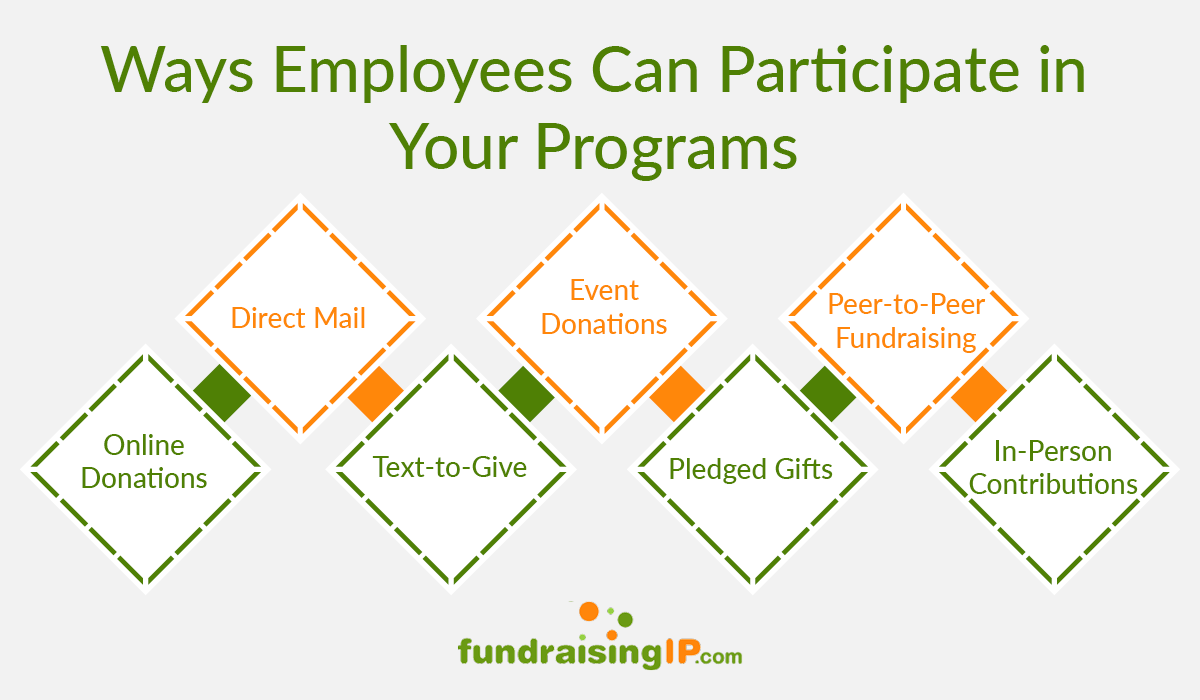
Nowadays, the modern nonprofit offers its supporters as many ways to give to their cause as possible. The easier it is to give, the more likely people will complete their donations—and the same concept can be applied to workplace giving participation!
These methods typically include the following:
- Online donations through a nonprofit’s website
- Direct mail giving
- Text-to-give services
- Event donations
- Pledged gifts
- Peer-to-peer fundraising campaign participation
- In-person contributions
If you decide to utilize a CSR platform to manage your company’s workplace giving programs, you might see that many of these software solutions even offer their own online fundraising and donation processing services.
However, you don’t want to narrow down the ways employees can give to just one of the above donation channels. To provide an optimized workplace giving experience, it’s of utmost importance to give employees a choice in the way they give. That way, they’ll feel more empowered to participate in workplace giving.
5. Enable auto-submission to streamline workplace giving.
Once you’ve established how employees can participate in your workplace giving programs, you’ll need to determine how they’ll submit their matching requests. This process, again, varies from company to company, ranging from paper forms to online request portals. Ultimately, you need a way for employees to provide your company with basic information about their recent donations in a timely manner. The simpler and more convenient the process, the higher participation will be.
One of the newest ways to facilitate matching gift requests is to leverage matching gift auto-submission technology. Leading matching gift database provider, Double the Donation, offers this innovative functionality in partnership with several breakthrough CSR platforms, including, Millie, POINT, Selflessly, and more.
But how does matching gift auto-submission work? Essentially, with auto-submission, completing a matching gift request becomes a two-step process.
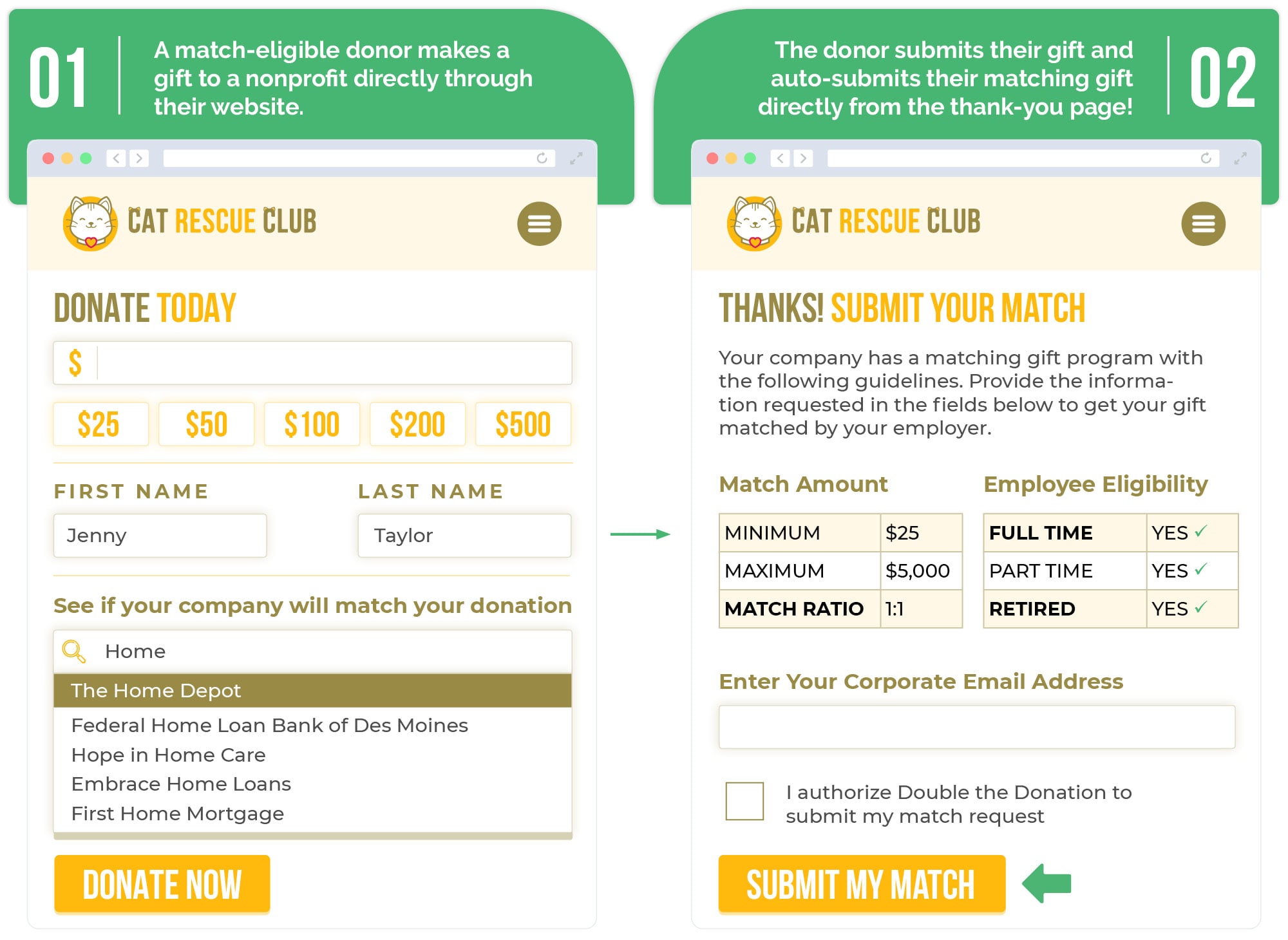
- A supporter makes a donation. Match-eligible supporters complete their donations as they normally would. During the donation process, they’ll either enter their work email address or receive a prompt to use a matching gift search tool to find and confirm their employer.
- The donor checks a box to opt into auto-submission. Using the information pulled from the donor’s email address or the company they selected from the search tool, the matching gift software will check if the employer has auto-submission enabled. If they do, the donor can simply check a box to opt into auto-submission and have their matching gift application completed for them.
All employees typically have to do to participate in auto-submission is verify their identity with a corporate email address and authorize Double the Donation’s matching gift platform, 360MatchPro, to submit the matching gift request on their behalf. From there, the software ecosystem provides the necessary donation data to your company’s workplace giving platform to automatically review and approve the request.
Your employees will appreciate the ease with which they can participate in your giving initiatives, which will likely result in increased program usage. And in the end, your company will see greater benefits from matching employee donations. It’s a win-win!
6. Promote your new workplace giving program to employees.
One of the reasons matching gifts are so underutilized is because the majority of donors are uninformed about them, meaning they don’t know if their employer offers such a program, if they qualify, or how to access it.
If your employees aren’t informed about your new philanthropic initiatives, they won’t be able to participate, and your company will not receive the benefits of participating in corporate philanthropy. To receive the many benefits of launching a workplace giving program, your organization needs to let people know it exists and provide them with clear direction on how they can tap into it.
To promote your new program to your staff:
- Highlight new programs across internal, company-wide communications (via email, in meetings, etc.).
- Include an overview of available giving programs in your employee handbook.
- Clarify who at the company is the go-to person for corporate giving program management and is available to answer any additional questions.
- Promote workplace giving to new employees during the hiring and onboarding processes.
Promoting workplace giving once when you first launch the program and then highlighting it to new employees is not enough to maintain active participation. Send regular reminders to employees about your workplace giving opportunities, especially if you notice participation rates flagging.
One positive way to remind employees about workplace giving is to share all the progress your program has made so far. If you’ve matched an impressive amount of contributions or total matches have exceeded a notable amount, let your employees know to encourage them to get involved and show them just how your organization is committed to social good.
7. Recognize your employees’ contributions.
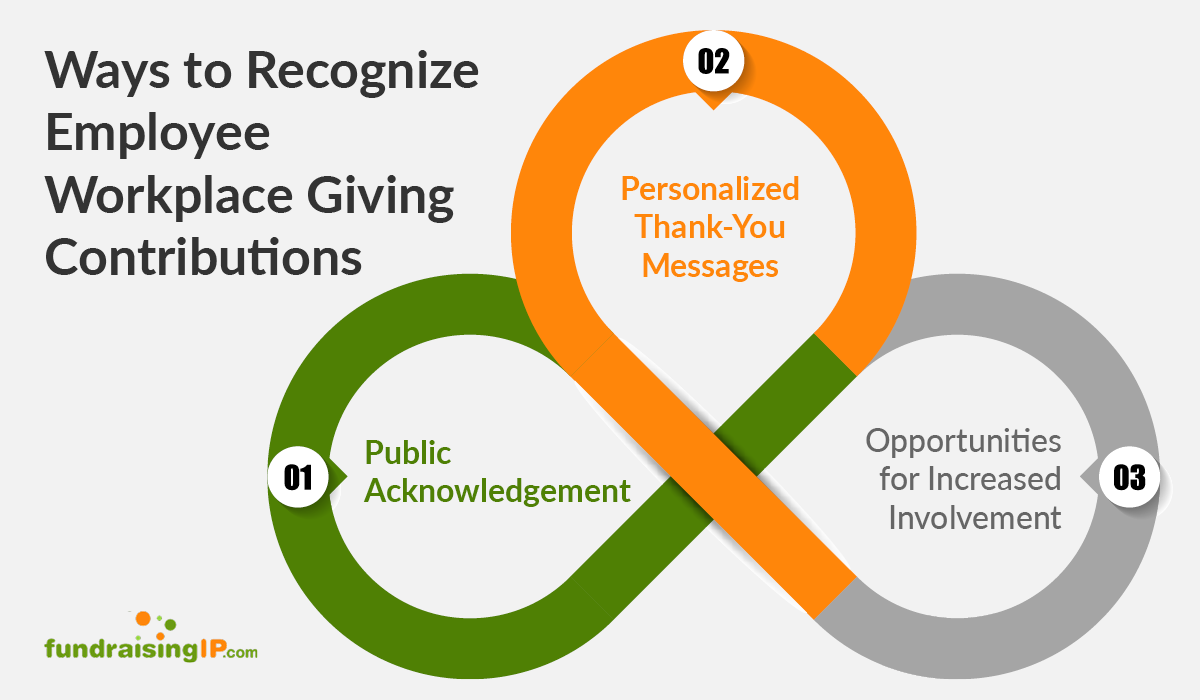
When a company acknowledges and celebrates its employees’ philanthropic initiatives, it sends a message that giving back is an important value within the organization. This can inspire other employees to get involved and foster a culture of giving.
Here are three ways to recognize your team’s accomplishments:
- Publicly acknowledge their contributions. Celebrate workplace giving efforts in a public and visible manner. This can include highlighting their contributions in company-wide meetings, newsletters, or social media platforms.
- Send personalized thank-you messages. Write personalized messages expressing your appreciation for their donation. Be specific about the impact their actions have made and how it aligns with the company’s values. To streamline the process, use eCard software. In a few minutes or less, you can create custom cards for each of your employees.
- Provide opportunities for increased involvement. Give employees opportunities to be directly involved in decision-making or planning processes related to workplace giving. For instance, you could invite them to join committees or task forces focused on corporate social responsibility.
Remember, recognition should be sincere, timely, and tailored to each employee’s contributions. With the right approach, you can create a positive workplace where employees feel valued and motivated to give.
Next steps and additional resources
Now that you understand the basic process involved with kicking off a workplace giving program for your business, it’s time to hit the ground running.
When you’re ready to launch, keep in mind that your employees play a significant role in the success of your philanthropic initiatives. Make sure the workplace giving program you build is one that your team members will be willing and eager to participate in.
If you’re looking for more information about workplace giving, take a look at the following resources:
- Corporate Giving and Matching Gift Statistics — If you need to convince your organization’s leaders to put a workplace giving program into place, use this list of corporate giving statistics to back up your proposal.
- How to Develop a Matching Gift Program: A Step-by-Step Guide — Matching gift programs are a convenient way to engage employees with workplace giving. Learn how to develop a program for your organization in this guide.
- The Ultimate Guide to Workplace Giving Platforms (+ Trends!) — Software simplifies implementing and running your workplace giving program. Check out this ultimate guide for the top platforms you should consider integrating with.



